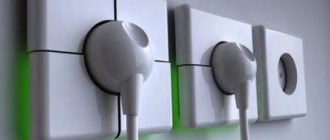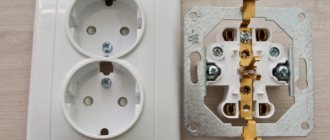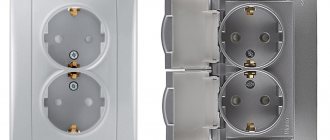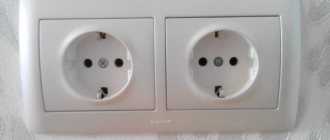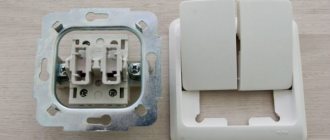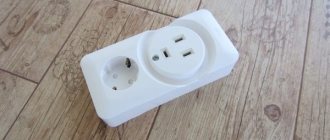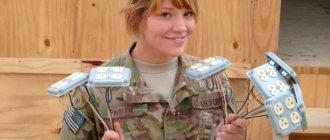A socket with a double connector will provide the ability to simultaneously power two devices connected to separate electrical points. In addition, for each of them there is no need to pull a cable, and it is more convenient to use thanks to the grouped arrangement.
You can handle the installation yourself without any problems if you take into account the recommendations we have given. We are ready to share the intricacies of electrical installation work. We will tell you in detail and show you how to connect a double socket, how to arrange a socket for an electrical outlet and ensure safe operation.
The information offered for review is supplemented with step-by-step photo guides, visual illustrations and videos explaining the nuances of installing and connecting power devices.
Types of double sockets
The main elements of an electrical outlet are the outer protective casing and the working part, which includes the base and contacts.
They are connected to each other by screw terminals - clamps necessary for connecting the cable of electrical equipment.
The only drawback of double sockets is that it is problematic to connect two high-power electricity consumers through them simultaneously
There is a misconception that double sockets are identical to assembled or dual models and represent several independent devices located close to each other, interconnected by cables.
If a double socket is connected to one power circuit, then electrical installation work is carried out according to a scheme similar to connecting a single socket. The only difference is the serial connection of two contact pairs within the electrical installation product
Technological progress does not stand still. Modern models are more advanced designs. In terms of rated voltage and current, they are strikingly different from the sockets that were ubiquitous during the Soviet era.
For example, if in old-style models the permissible current did not exceed 10A, then for modern electrical installation equipment this figure is 16A.
Each part of a double socket can be connected to a separate power circuit if you first remove the brass jumper connecting them at the terminal
In reality, a double socket has one clamp and several distribution strips. Due to this, the electric current is supplied to both sockets equally, but its level will be divided depending on the power of the devices powered from the network.
Therefore, when replacing a failed old device with a new one, it is worth knowing its design features, which require certain nuances during installation.
The distance between the output contacts, as well as the diameter of the plug pins, in modern models is larger than in traditional analogues, and is 4.8 mm instead of 4 mm
According to modification, double sockets are classified into the following main types:
- Open and closed version . In closed models, the holes are hidden behind curtains, which move to the side when the device is turned on. Devices of this type are indispensable for homes where there are small children. The curtains only work when pressed at the same time. Thanks to this, even if a foreign object is deliberately inserted, nothing dangerous happens.
- Without grounding and with grounding contacts . In models of the second type, grounding contacts are installed on the socket body, which protect electrical appliances and the user from breaking currents that accidentally “exit” the plastic body.
- For installation in rooms with high humidity and outdoor installation . Models of the first option are marked IP-44. They are equipped with a housing that protects the device from moisture penetration. Devices for outdoor installation are marked IP-55. Their highly durable housings are protected from dust contamination and moisture penetration.
Each type has a corresponding letter marking. For example: “A” indicates that this is an American double socket, “B” indicates the presence of a grounding contact.
Depending on the type of design and material of manufacture, devices are also divided into standard and polar, overhead and custom-made
Among the latest developments, programmed sockets are especially popular. Devices equipped with a timer turn on and off independently from the power supply after a set time interval has elapsed.
The protective housing of modern sockets is made of heat-resistant, unbreakable plastic. To enhance its decorative qualities, it is decorated with various inserts.
Thanks to the variety of design options, you can choose devices that will be invisible in the interior or, on the contrary, act as a worthy decoration.
When planning to install a double socket yourself, experts recommend choosing simple models without any modifications. Or give preference to double sockets with a spring-loaded plug ejector. Such models are convenient because they are equipped with springs that are activated when the plug is removed from the device.
To protect yourself by minimizing the risk of accidents, you should choose products from proven companies, ABB, and Legrand.
Connecting the socket to a three-wire network.
In the junction box, these wires are connected to two corresponding groups of light bulbs or fixtures.
If there is none, the general one is disabled.
If you don’t have a crown at hand, you can do without it. Next, we strip the insulation from the conductive cores by about 10 mm.
The location of the phase and neutral wires is shown as an example. If everything is done correctly, there should be no gaps left.
What do you need to know before connecting a double socket?
The location of the phase and neutral wires in the socket. Connection diagram for a socket with a three-button switch. The switch is turned off; at its input, zero comes through the light bulbs. The switch is turned on; through it, the phase goes to the light bulbs. Photo of a cosplay with five wires.
It is prohibited to have kinked or protruding ends of the wiring in the outlet. Another rule is wiring connection. The distance from one point to another should be at least 7 cm.
Connecting the socket to a three-wire network.
When the caliper frame is securely fastened, a decorative trim is installed. To dismantle the old socket, remove the front panel by unscrewing two screws. The connection of wires to screw terminals is carried out by wrapping them around the clamp clockwise or by pulling them between two plates. But basic knowledge of electrical safety techniques and skills in using a screwdriver, pliers and other tools are necessary. Manufacturers produce modifications for both hidden and open wiring for different current consumption and operating voltage.
One of them is connected to the phase wire of one lamp, the other to another. This is not always convenient and not everyone likes this aesthetic look. how to connect a double socket to 220V
Connection materials
The wire for connecting the electrical point must be made of the same metal as the main cable. For example, when using an aluminum cable, the jumper must also be made of aluminum.
To ensure an even distribution of incoming electricity, the cable used for connection must have the same cross-section as the main wiring in the room
To install a double socket you also need:
- flat and Phillips screwdrivers;
- braid stripping tool;
- pliers;
- insulating tape.
For safety reasons in case of fire, it is recommended that any electrical wires be laid in corrugation. This solution is also convenient because it does not require breaking through the wall, and also simplifies the replacement of damaged wires during subsequent operation.
Characteristics of sockets by voltage and frequency
Popular and in demand among domestic users are sockets with a voltage of 220V for connecting electrical appliances with a power of 3.5 kW. The limitations are due to the fact that low-power equipment is not able to cope with current strength that goes beyond 16A.
Products with voltage parameters of 240 and 380V are also available for sale. The sockets are intended for use in industrial enterprises where the current strength approaches 32A.
When choosing a product, pay attention to the frequency of alternating current. In our country, European standards with indicators of 50 and 60Hz are considered common.
Double socket installation technology
Installing a double socket in one socket box requires certain preparatory steps. The first step is to determine the identity of the wires by finding out where the phase and zero are.
The easiest way is to study the insulation code marking:
- the phase wire is painted red or brown (less often white or black);
- neutral has white-blue or light blue insulation;
- grounding is always green-yellow.
The following article will introduce you in detail to the features of marking electrical cable cores, which we recommend that you read. But for greater reliability, it is better to play it safe by taking measurements.
An indispensable assistant in this matter will be a regular or electronic screwdriver equipped with an indicator at the end - a light bulb or an LED indicator.
To determine the identity of the wires, remove the cover from the failed device and touch each exposed wire in turn with a screwdriver with a sensitive indicator: on the neutral wire there will be no light signal, and on the phase wire it will light up.
If there is no ground wire in the house, the installation work is a little easier.
Before you begin arranging an electrical outlet, you must de-energize the room. To do this, the levers of the circuit breakers on the panel are lowered down, moving to the “off” position. It is recommended to re-check the voltage at the location where the double socket is installed.
If there is still current in the phase, this indicates that not all supply lines have yet been de-energized. That’s why it’s so important to turn off all circuit breakers before starting work, and not limit yourself to just those that control the wires going to the outlet.
A double socket with a protective contact is installed if a grounding system for a private home is installed. In multi-storey buildings there is no point in using devices with grounding, because... zeroing has been done there
Marking the wall
The socket is placed near the wire running in the wall or from the electrical distribution box. The location of the future device is marked with a pencil.
Before installing a double socket with two “glasses”, it is necessary to determine the distance between the drilled holes. To do this, mark the center of the first socket box. This is the point of intersection of the diagonals. Using the same principle, the center of the second device is determined.
At the marked place in the wall, a recess is made of such dimensions that a glass - the inner body of the device - can easily fit into it.
To drill a hole in the wall itself, use a crown, the diameter of which is a couple of millimeters larger than the size of the purchased socket box. If there should be no problems with a brick or plasterboard wall, then to drill a hole to install a socket in a concrete wall, you will have to set the hammer drill to the shock mode.
The rules and technology for installing socket boxes in walls made of concrete and plasterboard will be familiarized with the material collected and systematized in our article.
The depth of the hole should be such that the “glass” does not protrude beyond the surface of the wall. Having drilled a niche, you need to clean its middle. To do this, use a chisel and a hammer. Plaster can be knocked off with a chisel or screwdriver without much difficulty.
Routing sockets and twisting wires
This stage is very important and must be approached with the utmost care and caution. The master’s task is to connect the power wire to the contacts. To do this, a wire is pulled from the junction box to a double socket.
The socket itself is disassembled into two components by unscrewing the mounting screws using a screwdriver, separating the front panel from the mechanism
The previously installed crown must be replaced with a drill. The diameter of the drill should be slightly larger than the cross-section of the wire supplied to the socket or the diameter of the corrugated pipe in the cavity of which the supplied wire will lie. The ideal option is when the diameters of the drill and wire match.
The main wire is inserted through one of the mounting holes of the socket box. And the auxiliary one is launched through the second hole.
Twisting of wires is performed directly in the “glass”. Before performing work, the outermost one and a half centimeters of the ends are stripped of the braid with a stripper - a tool that does not cut through the wire.
In the absence of one, you can use a sharp knife, first cutting the winding in a circle with it, and then carefully removing it from the wire. For ease of assembly, the edges of the cores are raised up.
To extend the service life of the socket, the exposed ends of the wires must be soldered, or a brass contact must be used. The second option is more successful, since it not only simplifies the subsequent use of the outlet, but also ensures high safety of the device.
When connecting wires, do not firmly clamp their ends into the terminals, since under the influence of great forces they can be damaged.
When connecting a grounded socket, always follow the wiring rule: on the right - phase, on the left - neutral. The grounding cable is connected to the top and central terminal of the device, which is equipped with protruding “antennae”, which often protrude beyond the body of the device. The grounding contact is fixed in the same way as phase and zero.
You cannot attach a phase and a neutral to the same plate, as this will cause a short circuit and damage to the entire wiring.
Having fixed the wires in the contact holes, unclench the “antennae” by unscrewing them clockwise using special bolts
Having completed the installation of electrical connections, proceed to the installation of socket boxes.
Subtleties of fastening socket boxes
The socket boxes with the power cables attached to them are secured using holders located on the sides. They may be included with the device, or they will have to be purchased separately. There are also models that are not equipped with fixing tabs, which are secured by screwing them onto screws.
As you tighten the screws clockwise, the fixing “legs” will diverge to the sides, firmly digging into the socket box
But since the socket box with the lever in the center experiences a double load, during operation the fastenings of the mechanism can become loose and weaken. When the socket boxes fall out, the wires are often exposed, which can lead to emergency situations.
To increase the reliability of fastening, craftsmen often use alabaster or cement mortar. To obtain a homogeneous thick mass, the structure of which resembles sour cream, dry alabaster is mixed with water. But keep in mind that the material should be diluted in small portions and you need to work with it quickly and carefully.
The alabaster mixture is placed in the place where it is planned to install the socket box. To ensure that the mixture adheres well to the surface, the inner edges of the hole should first be moistened with water.
Work on installing the inside of the device should be carried out 20-30 minutes after laying the mixture so that it has time to “set” a little. Having placed the “glass” on the prepared place and buried it in the mixture, level the position using a level and a hammer.
When installing a socket box, it is important to maintain the vertical and horizontal position of its position, applying a level in both planes for this purpose
The resulting gaps between the wall and the socket box are filled with the remains of alabaster. Without waiting for the plaster to acquire the desired strength, the sagging is removed with a knife.
Having placed the double socket horizontally or vertically and given the device the desired position, secure it with screws. If it is necessary to adjust the level, the work is performed using pliers.
When tightening the mounting screws, the main thing is not to overtighten them, otherwise, with strong pressure, the front panel may simply crack or collapse
At the final stage, the front panel is placed on top and clamped with screws. The decorating element will cover the unsightly part of the outlet and protect it from accidental damage.
After completing the connection of the outlet, all that remains is to turn on the circuit breakers and the residual current device in the panel and test the operation of the electrical installation equipment. It is better to check the operation of the outlet when turning on inexpensive household appliances, for example, a table lamp. After all, the slightest mistake during the installation process can cause a short circuit and “burnout” of household appliances.
Marking of sockets - description
Modern high-quality sockets have been improved to the maximum and have several protection parameters: from moisture, dust and dirt.
Marking is indicated by letter indicators (IP) and numbers:
- 0 – the product is not completely protected;
- 1 – protection against touching with fingers is provided and a ban on the penetration of solid particles larger than 5cm is provided;
- 2 - protection against touching with fingers and a ban on the penetration of solid particles with dimensions of 1.25 cm or more are provided;
- 3 – the socket is safe, provided with protection from accidental contact with power tools and other devices with dimensions larger than 2.5 mm;
- 4 – protection against penetration of solid particles with dimensions of 1 mm or more;
- 5 – the socket is partially protected from dust;
- 6 – maximum degree of protection, including against the ingress of microdust particles.
The second number indicated on the accessory indicates the degree of protection against moisture:
- 0 – device nodes are not protected;
- 1 – protection concerns vertical drops falling on the socket;
- 2 – protection concerns drops falling at an angle of 15 degrees;
- 3 – the device is protected from short circuiting when drops hit at different angles;
- 4 – the device is reliable, even if it gets splashed from the side;
- 5 – the presence of the second number 5 in the marking indicates that the socket can be washed, its operation is safe even if water enters the system without pressure;
- 6 – the device is capable of withstanding flows of water under pressure;
- 7 – it is allowed to immerse the element under water to a depth of no more than 1 m for a short time;
- 8 – deep diving is allowed;
- 9 – the device is completely sealed, it can be used under water for an unlimited time.
The indicated indicators are considered in relation to household appliances. There are also other markings indicating the strength of the case. They are rarely found on sale.
Preparatory work
In order for the 220V socket to be installed correctly, a number of preparatory work is necessary. For closed or open wiring it is similar, the differences are only in a few stages. To work you will need a set of the following tools:
- a screwdriver (it is better to take an indicator screwdriver to check the absence of voltage in the network),
- socket box (if it is missing or needs replacing),
- connection cable (if a complete installation is required, rather than replacing an old outlet with a new one),
- hammer drill (also necessary for complete installation of equipment),
- selected two-socket socket,
- knife with replaceable blades,
- screws,
- multimeter,
- wire cutters with insulated handles.
The work is performed in the following sequence:
- When choosing a point for open wiring (or closed), it is necessary to comply with the currently accepted rules for installing such electrical equipment. You cannot place sockets directly near the floor, and maintain distances from heating appliances and gas stoves.
- The power supply at the input panel to the apartment is turned off, and the absence of voltage must be checked using a multimeter or an indicator screwdriver. This is a mandatory condition necessary to comply with safety measures.
- The old socket is dismantled, leaving wire outlets sufficient for a new connection. To do this, you need to remove the outer decorative cover, press out the tabs, pull out the working part and carefully disconnect the wiring.
- The wires protruding from the socket box (if there is one) must be cleaned by removing approximately 20 cm of the insulating layer, then tucked back into the socket box.
